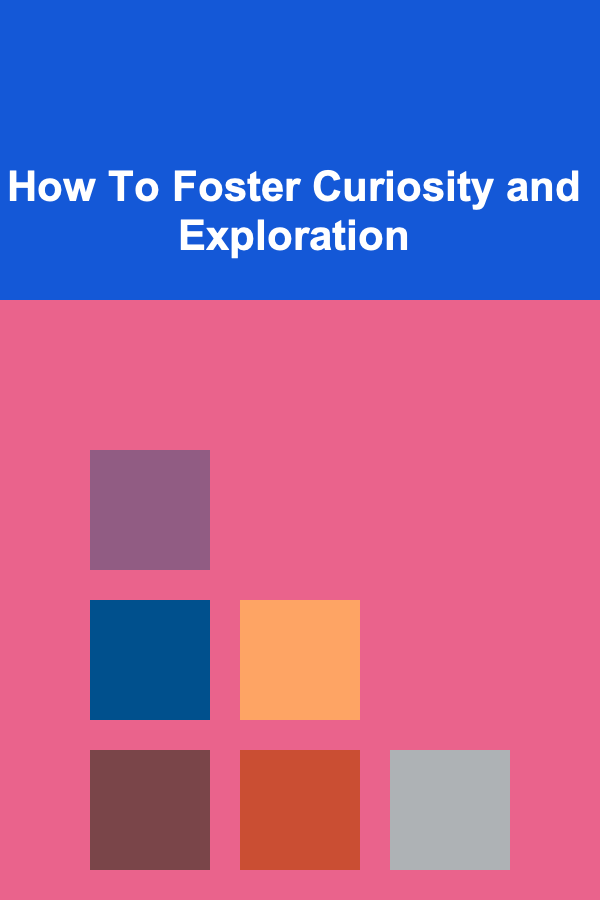
How To Foster Curiosity and Exploration
ebook include PDF & Audio bundle (Micro Guide)
$12.99$8.99
Limited Time Offer! Order within the next:

Curiosity is a natural instinct that drives individuals to explore, learn, and grow. It is the spark that ignites the pursuit of knowledge and discovery. Exploration, on the other hand, is the active pursuit of that curiosity---venturing beyond the known to uncover new territories, whether physically, intellectually, or creatively. Together, curiosity and exploration form the foundation of human progress, creativity, and innovation.
In a rapidly changing world, fostering curiosity and exploration is more important than ever. It empowers individuals to adapt to new situations, solve complex problems, and create novel solutions. But how do we cultivate these essential qualities in ourselves and others, especially in environments that may not always prioritize them? In this article, we will delve into the importance of curiosity and exploration, the challenges that hinder their development, and practical strategies to nurture them.
The Importance of Curiosity and Exploration
Curiosity is often described as the desire to know or learn something new. It is a trait that is central to human development and evolution. From an early age, children explore the world around them out of pure curiosity---asking questions, manipulating objects, and testing hypotheses about how things work. As they grow, curiosity becomes more complex, enabling individuals to tackle abstract problems and engage in deeper intellectual pursuits.
Exploration, whether literal (such as traveling to new places) or metaphorical (such as exploring new ideas or fields of study), expands our horizons. It is how we push the boundaries of what we know and understand. Exploration can lead to discoveries, inventions, and innovations that can radically change the world. From space exploration to the exploration of human consciousness, the act of venturing into the unknown is essential for progress.
In the context of education, both curiosity and exploration are crucial for fostering lifelong learning. When curiosity is nurtured, individuals are more likely to take the initiative in their learning, seek out new experiences, and engage in problem-solving. Exploration allows them to apply their knowledge in real-world settings, enhancing their understanding and enabling them to make meaningful contributions to society.
1.1. Curiosity as a Catalyst for Learning
Curiosity is the driving force behind learning. When individuals are curious about a topic, they are more likely to engage with it deeply, retain information, and apply it in novel ways. Curiosity encourages critical thinking and creativity, as individuals actively seek to understand the "why" and "how" of things. This intrinsic motivation to learn often leads to better academic performance and a greater sense of fulfillment in the learning process.
1.2. Exploration and Innovation
Exploration is at the heart of innovation. Many of the greatest achievements in human history were the result of individuals or groups who dared to explore the unknown. Whether through scientific discoveries, technological advancements, or artistic creations, exploration allows for the generation of new ideas and the solving of complex problems. When people explore new territories---whether in the natural world, intellectual fields, or creative endeavors---they often stumble upon insights that can lead to revolutionary change.
Barriers to Curiosity and Exploration
Despite its importance, curiosity and exploration are not always easy to foster. Several factors can hinder the development of these qualities, particularly in structured environments like schools, workplaces, and even within our own minds.
2.1. Fear of Failure
One of the biggest obstacles to curiosity and exploration is the fear of failure. When individuals are afraid of making mistakes or facing rejection, they are less likely to take risks and venture into new territories. This fear can manifest in different ways, from avoiding challenging tasks to limiting the scope of exploration to safe, familiar areas. Fear of failure stifles creativity and discourages individuals from asking questions or trying new things.
2.2. Fixed Mindset vs. Growth Mindset
The concept of a fixed mindset versus a growth mindset, as outlined by psychologist Carol Dweck, plays a crucial role in fostering curiosity. A fixed mindset is the belief that abilities and intelligence are static, leading individuals to avoid challenges or new experiences that might expose their perceived limitations. In contrast, a growth mindset encourages individuals to view challenges as opportunities for learning and development. Those with a growth mindset are more likely to embrace curiosity and exploration, seeing them as paths to personal and intellectual growth.
2.3. Lack of Time and Resources
Curiosity and exploration require time, energy, and resources---whether mental, physical, or financial. In environments where individuals are pressed for time or lack access to necessary resources, the opportunity for exploration diminishes. This is particularly true in academic or work settings, where the focus may be more on completing tasks or meeting deadlines rather than fostering curiosity or creative exploration.
2.4. Conformity and Social Pressure
Social pressures and cultural norms can also stifle curiosity. In societies or environments that prioritize conformity, individuals may feel discouraged from asking unconventional questions or pursuing non-traditional paths. The desire to fit in or meet societal expectations can deter people from exploring ideas that are considered outside the norm. This is particularly common in educational settings, where students may be rewarded for giving the "right" answers rather than for posing original questions or exploring alternative solutions.
2.5. Overload of Information
In today's digital age, we are bombarded with information from multiple sources, often leading to cognitive overload. This overwhelming influx of data can cause individuals to shut down their curiosity or focus on surface-level exploration without going deeper into subjects. The constant stream of news, social media, and entertainment can distract individuals from engaging in meaningful exploration and critical thinking.
Strategies to Foster Curiosity and Exploration
While there are many barriers to curiosity and exploration, there are also effective strategies that can help individuals overcome these obstacles and cultivate a more curious and explorative mindset. These strategies can be implemented in educational settings, workplaces, and personal life.
3.1. Create a Safe Space for Experimentation
One of the best ways to encourage curiosity and exploration is by creating an environment that values experimentation and learning from failure. When individuals feel safe to take risks, make mistakes, and learn from their experiences, they are more likely to explore new ideas and approaches. This can be achieved by promoting a culture that celebrates innovation, curiosity, and trial-and-error rather than perfection.
In educational settings, teachers can foster a safe space by encouraging students to ask questions without fear of judgment and by praising effort and persistence over correct answers. In the workplace, leaders can create a culture of experimentation by supporting employees who propose new ideas and allowing room for trial and error.
3.2. Encourage Open-Ended Inquiry
To promote curiosity, it is important to encourage open-ended inquiry. Rather than simply providing answers, leaders, teachers, and mentors should ask thought-provoking questions that stimulate deeper thinking. Open-ended questions such as "What if?" or "Why do you think that happens?" encourage individuals to explore ideas and challenge assumptions.
This can also be applied in everyday life. Encourage children to ask questions and engage in discussions that prompt them to think critically and explore different perspectives. For adults, engaging in thought-provoking books, documentaries, or discussions can open new avenues of exploration.
3.3. Promote a Growth Mindset
As mentioned earlier, a growth mindset is essential for fostering curiosity and exploration. Individuals with a growth mindset are more likely to embrace challenges and view setbacks as opportunities for learning. To cultivate a growth mindset, individuals should focus on effort, resilience, and continuous learning rather than innate talent or ability.
In educational and professional settings, providing constructive feedback that emphasizes growth and improvement---rather than simply success or failure---can encourage a growth mindset. Encouraging students or employees to view mistakes as part of the learning process can also help them become more open to exploration and risk-taking.
3.4. Provide Opportunities for Exploration
Creating opportunities for exploration is key to fostering curiosity. This can be done by providing individuals with access to new experiences, whether through travel, hands-on learning, or exposure to different fields of study. Field trips, extracurricular activities, and cross-disciplinary projects can give individuals the chance to explore new environments and ideas outside of their usual routines.
For instance, in the workplace, offering employees opportunities to work on diverse projects, attend conferences, or collaborate with other departments can stimulate curiosity and foster a culture of exploration. In educational settings, providing students with interdisciplinary learning experiences or opportunities for independent research can encourage them to pursue their interests and explore new areas of knowledge.
3.5. Encourage Mindfulness and Reflection
Mindfulness practices, such as meditation and reflective journaling, can also play a significant role in fostering curiosity and exploration. Mindfulness helps individuals become more aware of their thoughts, feelings, and surroundings, creating space for curiosity to flourish. By taking the time to pause and reflect, individuals can gain new insights and develop a deeper understanding of the world around them.
Encouraging regular reflection on experiences, whether through journaling or group discussions, can also help individuals gain new perspectives and connect ideas in creative ways. This practice promotes a sense of wonder and curiosity about the world, which in turn encourages exploration.
3.6. Provide Access to Resources
Curiosity thrives when individuals have access to resources that enable exploration. This can include access to books, online courses, creative tools, or mentors. By providing individuals with the resources they need to explore their interests, they can take the initiative to learn and discover new things independently.
Libraries, online platforms, and professional networks can all serve as valuable resources for fostering curiosity. In the workplace, offering access to training programs, conferences, and collaborative tools can give employees the resources they need to explore new ideas and develop their skills.
Conclusion
Curiosity and exploration are fundamental to human growth, innovation, and progress. They fuel learning, creativity, and problem-solving, enabling individuals to adapt to new challenges and contribute meaningfully to society. Despite the barriers that may hinder curiosity, there are numerous strategies that can be employed to foster these qualities.
By creating safe spaces for experimentation, promoting a growth mindset, encouraging open-ended inquiry, and providing opportunities and resources for exploration, we can cultivate curiosity and exploration in ourselves and others. Whether in educational settings, workplaces, or personal life, fostering curiosity is a powerful way to encourage lifelong learning, creativity, and positive change.
In a world that is constantly evolving, the ability to stay curious and explore new possibilities is more important than ever. Let us embrace the unknown, ask questions, and explore the world with wonder and enthusiasm.

How To Improve Your Memory and Concentration
Read More
How to Keep Your Family Room Tidy with Daily Routines
Read More
How to Prepare Your Rental Property for Inspections and Appraisals
Read More
How to Soundproof Your Home for a Home Recording Studio
Read More
How to Create a Wedding Planning Checklist for a Tight Budget
Read More
10 Tips for Budget-Friendly Boating Vacations
Read MoreOther Products

How To Improve Your Memory and Concentration
Read More
How to Keep Your Family Room Tidy with Daily Routines
Read More
How to Prepare Your Rental Property for Inspections and Appraisals
Read More
How to Soundproof Your Home for a Home Recording Studio
Read More
How to Create a Wedding Planning Checklist for a Tight Budget
Read More